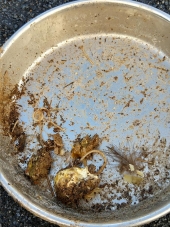Roundworms. The general wisdom is that if one chicken has them, then the whole flock must have them. But in practice, I found out that this is not necessarily true. I kept many birds over the years, and I met a lot of health problems with them, but it was always just one suffering from something, even if that something was reputedly contagious. This actually makes sense, because they are all individuals, with different genetics, different personalities and places in their coop hierarchy, so with different levels of stress. Something else that varies is also what they get to eat, maybe the shy ones don’t eat as many of the scarce goodies. Anyway, I had only one with worms, and it was exactly the one who was also the most susceptible to scaly leg mites.
In this case, if the egg production is poorer than it should be for her breed and age, then I would do something. Not mainly to get eggs, but because not laying as she should is an indication of all not being well with her.
Actually, Yeka, I saw your other post recently about the hen Muffy, and was meaning to ask what you feed them as a staple and what extras they get, because it’s possible by the look of her feet that Muffy could have gout. We’ll talk about that in the other thread, but it’s relevant here too, what do you feed them?
About de-worming medication: pharma has quite a few products that paralyze or kill the worms, but the drawbacks are:
1. Even if they get rid of the worms present in the body, they don’t make the body unwelcoming to worms in the future. So the chicken(s) susceptible to worms will remain susceptible to worms.
2. Liver toxicity. This one happens because it’s difficult to dose and monitor everyone carefully. Some can get too much. Maybe there’s one who can’t tolerate even the correct dose, and tragically maybe that same one didn’t even need to be treated in the first place. Deaths and injuries can happen from de-worming gone wrong.
3. You have to throw out the eggs for a while.
Luckily, in homeopathy we have something just as strong as a pharma chemical, but with none of the drawbacks, and lol it’s not “too good to be true”. By the way, there’s a professional homeopath here on permies who started a thread last year, I’ve been meaning to contribute there with a little history about the events that led to the state of affairs of today, when so few people know and use homeopathy.
To get started, I suggest this short article by another professional homeopath, who gives a lot of free advice to the permies. This specific article deals with the treatment of roundworms. Even better to go through the comments too.
https://joettecalabrese.com/blog/what-you-cows-and-worms-have-in-common-cina/
My hen really needed to be treated so I ordered her homeopathic pills and waiting for them to arrive I gave her a little freshly minced garlic in her feed (daily, because it was an emergency, but just a little). The Allium family plants (meaning mainly onions and garlic to a lesser extent) are to be given sparingly and occasionally because in large quantities they give the birds hemolytic anemia. Anyway, this is what I read, and the problem is with the onions mainly. Garlic is so great that it’s tempting to give some daily, but because avian vets warn about hemolytic anemia, I usually add it just once or twice a week. Except for the worm emergency.








